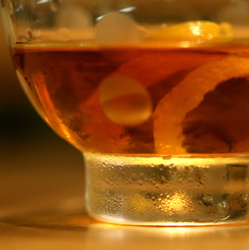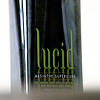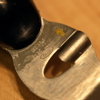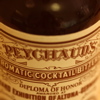DOTW: Sazerac
 Not too long ago, we got together with our neighbors Erik and Mrs. Flannstad for an absinthe tasting. We cracked open our new bottle of Lucid, the first true absinthe to be sold legally in the United States in nearly 100 years. Our guests generously offered to share tastes of two absinthes that they had brought back across the pond: Jade 1901 and Fougerolles.
Not too long ago, we got together with our neighbors Erik and Mrs. Flannstad for an absinthe tasting. We cracked open our new bottle of Lucid, the first true absinthe to be sold legally in the United States in nearly 100 years. Our guests generously offered to share tastes of two absinthes that they had brought back across the pond: Jade 1901 and Fougerolles.
As we dripped cold water over sugar cubes and watched the clear green fluid louche, I was struck by the historic nature of our ceremony: It is no small thing to be a party to the greatest snake-oil scam of the last three centuries.
Like many of today’s cordials, absinthe was first promoted as a medicinal elixir. The benefits supposedly arose from the combination of anise, fennel, and grande wormwood, and it was given to French troops as a fever preventative. When the drink became spectacularly popular in France by the late 1800s, it captured the palates and imaginations of several well-known artists, and the allure of the liquor shifted shape. Absinthe, no longer medicine, acquired a reputation as a mind-altering hallucinogen. By 1915 it was considered so dangerous that it was banned in several countries, including France and the United States.
Alas, recent studies have proven that absinthe does not cause hallucinations. I wasn’t able to find anything written on its efficacy as a fever remedy, but I don’t anticipate absinthe putting aspirin or ibuprofen manufacturers out of business any time soon. Nevertheless, the legend, mystique, and flim-flam continues, thoroughly documented by the Wormwood Society and La Fee Verte Absinthe House. The story of a humble patent medicine that grew into a potion so potent as to be banned on two continents is one that would bring a tear to any huckster’s eye.
Happily, absinthe also makes a pleasant drink, and we had fun tasting and comparing the three examples. Of the three, the Lucid was the sweetest and least complex. Despite bringing up the rear in our taste test, Lucid has two strong points in its favor. First, it strikes far closer to absinthe’s correct flavor profile than any of the current substitutes. Second, its modest price and local availability means that absinthe once again becomes fair game for mixological experimentation.
Sources tell us that many cocktails made with pastis (a la Ricard or Pernod) were originally made with — you guessed it — absinthe in the days before the ban. One such recipe, the venerable New Orleans staple known as the Sazerac, looks on paper like a shot of whiskey with some incidental flavorings. But a well-made Sazerac honors its pedigree: One of the oldest of all cocktails, it’s a parade of enchanting flavors that starts with lemon and ends with an herbal snap. Make it with the original American whiskey — rye — in place of that johnny-come-lately bourbon, and you’ve got a taste of cocktail history in an old-fashioned glass.
Vieux Sazerac
1/2 tsp absinthe
1/2 tsp simple syrup
2 dashes Peychaud bitters
2 oz rye whiskey
lemon twist, for garnish
Add the absinthe to a well-chilled old-fashioned glass, and roll it around to coat the inside of the glass. Pour out the excess, leaving a small puddle in the bottom of the glass. Add syrup, bitters, and rye; stir, and garnish with lemon twist.
Note: As this drink lacks ice, think “extra frosty” when chilling the glassware.









Comment by Anita
I should add that “local availability” in this case is relative: We shipped our bottle from these guys: http://www.drinkupny.com/product_p/s0390.htm.
But overnight freight was free — compare that with a week or more and astronomical shipping charges from France or the UK.
The folks at Lucid say they’re rolling out nationwide, but so far mail order is your best bet… even if most places are out of stock until the end of the month.
Posted on 07.06.07 at 7:15AM
Comment by Dayne
Hi Cameron and Anita-
It’s my understanding — and I could be wrong, but I’ll know after next week visiting New Orleans — that the Sazerac is traditionally made using two glasses. One is chilled (frozen, ideally) as you indicate, and gets the absinthe/pastis wash. The other gets the syrup, bitters, and rye [or cognac, which is excellent as well], *and* some ice. It’s stirred a bit, then strained into the chilled glass. This has the dual effects of making the drink colder (duh) and adding some needed water via dilution, to let the whole drink open up a bit.
Looking forward to trying the Lucid! I have a diminishing supply of Ted Breaux’s Jade Edouard 72 that I like to use for Sazeracs, but definitely need a domestic source for a reasonable substitute!!
Posted on 07.06.07 at 9:36AM
Comment by Cameron
Hi Dayne!
While researching this entry, we found recipes that used ice in the preparation, and the versions that I’ve had in bars of cocktailian repute have been made that way. I didn’t really think about it until I ran across Robert Hess’ ice-less rationale on DrinkBoy, which we linked to from the body of our recipe. We felt that the undiluted version brought the absinthe, lemon, and bitters flavors forward, and we liked the effect.
Please let us know how they make ’em in The Big Easy!
Posted on 07.06.07 at 10:11AM
Comment by erik_flannestad
If you’re lucky, in New Orleans, Sazeracs will be made the that’s described on the gumbopages link.
Funny, about the DrinkBoy link. I mean, a Sazerac is already pretty much just cold slightly flavored whiskey. Interesting that Robert would advise skipping the small amount of water that results from stirring with ice!
But, I imagine it kind of depends on the whiskey and the drinker. While I guess I can see the no ice method working with Old Overholt, I’m not sure I would try it with Wild Turkey, Rittenhouse 100, or Thomas Handy. A little extra water is good to calm those more ardent spirits.
Posted on 07.06.07 at 12:12PM
Comment by Jimmy
Good post. How did you like the Fougerolles? I really like it and it is my standard for the Sazerac. I think Erik told me it was his “house” brand. I hope we see a few choices in the absinthe market moving forward.
Posted on 07.06.07 at 12:54PM
Comment by erik_flannestad
I’ve been OK with the Verte de Fougerolles up to this point; but, was recently spoiled by trying the Jade PF 1901.
The VdF ends up tasting pretty brash and unpolished next to the Jade.
VdF vs. Lucid is a little harder to call. Without shipping, they’re about the same price, and there are things I like and dislike about the character of both.
Anyway, it appears that 2 or three other well regarded European Absinthes with a tested thujone content under 10 PPM will soon be making their way to the US market. So, yes, it appears we Americans will have some choice in the matter.
Plus, I think we’re lucky the TTB rule prevents the sale of the truly awful Absinthes that trade on their extreme Thujone content as a selling point.
~Erik
Posted on 07.09.07 at 10:30AM
Comment by Wendy
We had the opportunity to both drink with Ted Breaux and attend his absinthe seminar at Tales- very interesting and the 1901 was really nice! We have a bottle of his other one- Edward?? so will need to get a side by side with Lucid and 1901 to see which is the best. He has an amazing amount if info in that head of his and is truley passionate and committed to bringing absinthe back to the states.
Posted on 07.27.07 at 2:39PM
Comment by Louise
And Hangar One/St George is releasing their own absinthe Dec 21.
Posted on 12.09.07 at 8:17PM